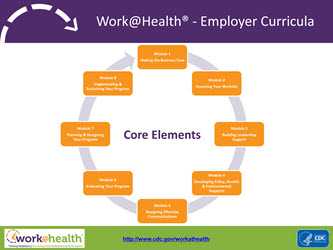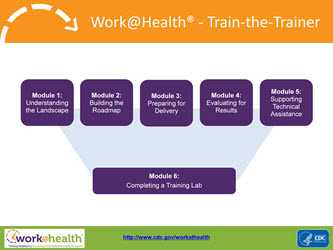Training and Implementation
Employer Training
The Work@Health Core Curriculum helps employers develop a basic skill set and capacity to build or enhance a science-based worksite health program. The training is targeted to employers of various sizes (but particularly small businesses), geographic distribution and industries. Training in the Core Employer Curriculum is delivered through eight core modules described below.
Module 1. Make the Business Case
Learning Objectives: After completing this module, participants will be able to:
1. Identify the value and benefit of a worksite health program;
2. Describe success factors;
3. Develop a business case for their employer’s leadership.
Peer Learning Activity: At the end of this module, participants will draft a value statement that answers the question: “Why build a worksite health program for my employees?”
Module 2. Assess the Worksite
Learning Objectives: After completing this module, participants will be able to:
1. Describe common health and productivity-related metrics and their relevance to worksite health programs;
2. Identify and interpret their worksites’ health promotion needs and interests based on available data and tools;
3. Assess their worksites’ organizational capacity using the CDC Worksite Health ScoreCard.
Peer Learning Activity: At the end of this module, participants will analyze their scores on the CDC Worksite Health ScoreCard and plan their assessment strategy.
Work@Health® Employer Curricula
Module 3. Build Leadership Support
Learning Objectives: After completing this module, participants will be able to:
1. Describe the value of and need for establishing a “Total Leadership Model”;
2. Secure and maintain senior- and middle-management participation/support;
3. Establish health promotion committee and peer-support network (these may be your health promotion champions).
Peer Learning Activity: At the end of this module, participants will lay the framework for developing a Total Leadership Model by identifying key stakeholders at their worksites.
Module 4. Develop Policy, Benefit, and Environmental Supports
Learning Objectives: After completing this module, participants will be able to:
1. Implement policies supporting preventive screenings, tobacco cessation, healthy eating, and regular physical activity;
2. Make benefit changes related to improving employee participation and job satisfaction;
3. Create environmental supports that encourage healthy behaviors.
Peer Learning Activity: At the end of this module, participants will complete a “Closing the Gaps” worksheet to formulate multiple strategies to improve their scores in focus areas of the CDC Worksite Health ScoreCard.
Module 5. Design Effective Communications
Learning Objectives: After completing this module, participants will be able to:
1. Conduct a communications audit;
2. Develop a unique brand;
3. Select media/distribution channels to address their worksite programming goals and objectives.
Peer Learning Activity: At the end of this module, participants will use a checklist to rate the effectiveness of various methods of communication at their worksites.
Module 6. Evaluate the Program
Learning Objectives: After completing this module, participants will be able to:
1. Describe the different types of program evaluation;
2. Align measures with their program goals and objectives;
3. Establish baseline measures to evaluate impact and report results;
4. Integrate evaluation within planning processes.
Peer Learning Activity: At the end of this module, participants will use a checklist to identify potential evaluation elements for their programs.
Module 7. Plan and Design the Program
Learning Objectives: After completing this module, participants will be able to:
1. Identify and prioritize their needs using relevant data from Module 2 (Assessing the Worksite);
2. Use the Work@Health® Program Planning Template to create strategic plans and design their program components;
3. Design specific program options to build and sustain better health and a culture of health among their employees.
Peer Learning Activity: At the end of this module, participants will conduct a review of their current and potential programs and assess their program.
Module 8. Implement and Sustain the Program
Learning Objectives: After completing this module, participants will be able to:
1. Involve their health promotion committees;
2. Implement a master schedule;
3. Initiate operational approaches to manage and sustain their programs;
4. Manage the evaluation process;
5. Access technical assistance to support development of their worksite health programs.
Peer Learning Activity: At the end of this module, participants will use the Program Design Worksheet to health promotion activities/events.
Train-the-Trainer
Work@Health® Train-the-Trainer (certified) training will provide employers and other participants with the knowledge and tools to train employers how to promote good health in their work places. Participants will be able to use the information to prevent or reduce chronic illness and disability, and improve productivity and employer competitiveness of employers participating in this training program. Training is for individuals and organizations who have a strong interest in workplace health and building capacity among employers in their community. The curriculum is delivered through five core modules and training lab described below.
Module 1. Understand the Landscape
Learning Objectives: After completing this module, trainees will be able to:
- Describe goals, objectives, and core elements of Work@Health®;
- Define their roles and responsibilities while training employers to implement the Work@Health® Core Curriculum;
- Assess how their current knowledge and skills match the characteristics of effective trainers.
Module 2. Build the Roadmap
Learning Objectives: After completing this module, trainees will be able to:
1. Distinguish between different adult learning styles;
2. Understand the different training models;
3. Deliver effective and engaging training and technical assistance using specific presentation and communication skills.
Work@Health® Train-the-Trainer Curricula
Module 3. Prepare for Delivery
Learning Objectives: After completing this module, trainees will be able to:
1. Plan for learning with various Work@Health® training models (Hands-on, Online, Blended);
2. Develop techniques to create a positive learning environment;
3. Apply strategies to ensure the fidelity of the Work@Health® Core Curriculum.
Module 4. Evaluate for Results
Learning Objectives: After completing this module, trainees will be able to:
1. Describe the importance of evaluation;
2. Understand why it is important to develop/design evaluation with program goals and objectives;
3. Apply assorted Work@Health® evaluation tools in the worksite setting.
Module 5. Support Technical Assistance
Learning Objectives: After completing this module, trainees will be able to:
1. Explain the value of technical assistance to employers;
2. Apply a range of technical assistance services to support employers and trainers;
3. Describe how the Work@Health® Technical Assistance Learning Community works.
Module 6. Complete a Training Lab
Learning Objectives: After completing this module, trainees will be able to:
1. Deliver a 15-minute hands-on module session;
2. Provide feedback to an employer for an online practice activity;
3. Customize and deliver topics for planning and implementation tasks.
The role of the Work@Health® trainer is to:
- Provide foundational worksite health training and technical assistance to engaged employers.
- Help employers understand how to establish worksite health programs proven to work.
- Enable employers to implement the Work@Health® Core Curriculum with fidelity.
What makes a good Work@Health® trainer is:
- Knowledge of (and preferably hands-on experience with) elements and practices that include/support a comprehensive, integrated worksite health program for employers of all sizes.
- Excellent face-to-face and online presentation, motivational, and problem-solving skills.
- Ability to customize Work@Health® Core Employer Curriculum elements for the needs and resources of the target employer.
- Creative ability to recommend appropriate resources to address specific areas.
- Ability to tell stories and apply content in relatable terms.
What is a Work@Health® Wellness Champion?
The Work@Health® program provides expert training, technical assistance, and support to employers nationwide dedicated to building effective worksite health programs.
Work@Health® Wellness Champions are organizations and/or employers that have demonstrated a commitment to promoting the Work@Health® program within their respective networks.
Recognized W@H Wellness Champions will use their networks and contacts to promote the W@H program to potential employers and professionals with an interest in becoming Work@Health® certified trainers.
These organizations include:
- Health departments
- Business coalitions
- Professional associations
- Public health‐based non‐profits
- Trade associations
Work@Health® Wellness Champion Benefits
- Recognized by the CDC as a Work@Health® program partner and a committed stakeholder to building comprehensive and sustainable worksite health and wellness programs.
- Build the worksite wellness expertise and capacity of your organization and members.
- Access to the most up‐to‐date worksite wellness resource materials, which can be shared with the Wellness Champion’s networks.
- Priority placement for future Work@Health® training opportunities and classes.
What do Work@Health® Wellness Champions Do?
- Promote the Work@Health® program to its network members and potential Work@Health® participants.
- Appoint a Work@Health® point of contact responsible for coordinating Work@Health® promotion.
- Assist the Work@Health®program team with follow up activities.
- Consider becoming a participant in the Work@Health® Train‐the‐Trainer Program to learn how to be a resource for its membership.
For more information about becoming a Work@Health® Wellness Champion send an email to workathealth@cdc.gov with the subject line “Wellness Champion”
- Page last reviewed: April 1, 2016
- Page last updated: April 1, 2016
- Content Source:


 ShareCompartir
ShareCompartir


